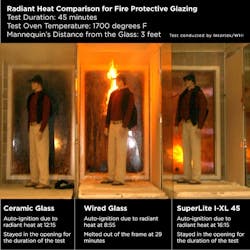Specialty tempered glass??
When it comes to choosing a glazing product for applications requiring durability, strength and safety, architects have long chosen tempered glass. Having ten times the strength of annealed glass, it’s used prevalently in doors, sidelites and other potentially hazardous locations requiring safety glazing in compliance with ANSI Z97.1 and CPSC 16 CFR 1201 performance standards. Tempered glass is also an excellent choice for large expanses of glass that maximize clear views while providing significant wind load and thermal stress resistance.
The Manufacturing Process of Tempered Glass
The strength and safety properties of tempered glass is achieved by heating annealed glass in a tempering oven between 1100 – 1150 degrees F. The glass surface is then rapidly cooled with high-pressure blasts of air, causing the outer surfaces of the glass to cool and contract faster than the center. As a result, the surfaces of the glass are in compression while the core is in tension to balance it giving the glass its strength.
This process also gives tempered glass a distinct break pattern. Annealed glass breaks easily and fractures into large, sharp pieces that can inflict significant harm or injury. In contrast, because tempered glass is ten times stronger, it fractures into relatively small pieces when broken. This significantly reduces the chances of injuries or harm.
Specialty Tempered Glass for Use in Fire Rated Applications
Specialty tempered glass undergoes a more extreme heating and cooling cycle than standard tempered glass intended simply as safety glazing. The unique tempering process it undergoes in combination with special edge treatment significantly increases the glass’ resistance to impact and thermal stress.
Specialty tempered glass for use in fire rated applications was designed and has been used extensively in Europe for over 45 years. Specialty tempered glass is produced by major fire rated glass manufacturers such as NSG Group/Pilkington and St. Gobain/Vetrotech, and widely used in 20 and 45 minute fire protective applications around the world wherever the hose stream test is not required. In the US, the hose stream test is not required for 20 minute doors, but is still part of the test procedure for 45 minute doors and openings.
Developed in the 1890’s, the original purpose of the hose stream test was to test the structural integrity of building components when subjected to a fire. At that time, materials like cast iron were used in the foundation. During a fire, these cast iron members became extremely hot, and the rapid cooling from the responder’s hoses would compromise the building’s structural integrity. The hose stream test was never intended to test the thermal stress performance of glass, which is not a structural element. (See video - What the Hose Stream Test is Not)
In actuality, when firefighters arrive at the scene of a fire, their intention is to break through the glass and other non-structural building materials and get to the fire – not to see how long the glass or these other building materials will stay in the opening or how it will behave when water is applied. Click here to read more on the hose stream test.
The Advent of SuperLite I-XL 45
In 1996, SAFTI FIRST tested and marketed our USA-made specialty tempered product, SuperLite I-XL 45. It was met with significant industry push-back because its costs were significantly less than filmed or laminated ceramics. SuperLite I-XL 45 doesn’t have any amber tint typical of ceramics, meets ANSI Z97.1 and CPSC Cat. II impact safety requirements and offers partial radiant heat protection to facilitate safe egress – making it the perfect product for 45-minute applications.
The sellers of ceramics and other competitive products, specifically TGP, that aggressively market and distribute their ceramic products here in the US, realized that these beneficial qualities would have a negative effect on the market. As mentioned earlier, these sellers market a specialty tempered glass product in 20-45 minute fire protective applications around the world, but here in the US they fought tooth and nail to disallow a code change to approve the use of a specialty tempered product like SuperLite I-XL 45 by attacking its’ only drawback – it was unable to withstand the rapid cooling from the hose stream at the end of the 45-minute, 1800 degree F fire endurance test. Because of this SuperLite I-XL 45 has to be submitted as an alternative fire rated glazing material to the AHJ (Authority Having Jurisdiction) under section 104.11 of the International Building Code (see footnote below).
Even with the industry pushback as detailed, SuperLite I-XL 45 is accepted by the GSA (General Services Administration) and numerous AHJ’s across the US (see list) as an alternative fire rated glazing material in 45 minute applications for the many benefits that it offers. To catalog these benefits: SuperLite I-XL 45 meets impact safety requirements without needing films or lamination; it provides partial radiant heat protection not provided by ceramics or wired glass used in the same application; it is optically clear and colorless.
Building officials, designers and end-users accept the fact that at 45 minutes, radiant heat protection that allows for safe egress is far more important than a glazing product’s resistance to thermal shock (see video - Radiant Heat: The Invisible Killer). There are several resources available on our website regarding SuperLite I-XL 45, including a Technical Bulletin that is designed for design professionals and AHJs.
A fully code-compliant product that meets hose stream is affordable and provides full radiant heat protection is another SAFTI FIRST’s 45-minute tempered product!!!
SuperLite II-XL 45 meets hose stream and provides full radiant heat protection. You can find out about this product in our previous blog titled, “Is Fire Rated Glass Expensive?”. SuperLite II-XL 45 is clear and more affordable than ceramic alternatives while meeting all the fire and safety testing requirements. As a reminder, all of SAFTI FIRST’s products are proudly made in the USA as opposed to ceramics.
If you have questions or do not hesitate to give us a call at 888.653.3333.
************************
Footnote:
1 Building codes allow SuperLite I-XL 45 to be submitted to the AHJ (authority having jurisdiction) as an alternate material in 45 minute applications under Section 104.11 of the International Building Code:
104.11 Alternative materials, design and methods of construction and equipment. The provisions of this code are not intended to prevent the installation of any material or to prohibit any design or method of construction not specifically prescribed by this code, provided that any such alternative has been approved. An alternative material, design or method of construction shall be approved where the building official finds that the proposed design is satisfactory and complies with the intent of the provisions of this code, and that the material, method or work offered is, for the purpose intended, at least the equivalent of that prescribed in this code in quality, strength, effectiveness, fire resistance, durability and safety.
The commentary section further states that:
The code is not intended to inhibit innovative ideas or technological advances. A comprehensive regulatory document, such as a building code, cannot envision and then address all future innovations in the industry. As a result, a performance code must be applicable to and provide a basis for the approval of an increasing number of newly developed, innovative materials, systems and methods for which no code text or referenced standards yet exist. The fact that a material, product or method of construction is not addressed in the code is not an indication that such material, product or method is intended to be prohibited. The building official is expected to apply sound technical judgement in accepting materials, systems or methods that, while not anticipated by the drafters of the current code text, can be demonstrated to offer equivalent performance.

